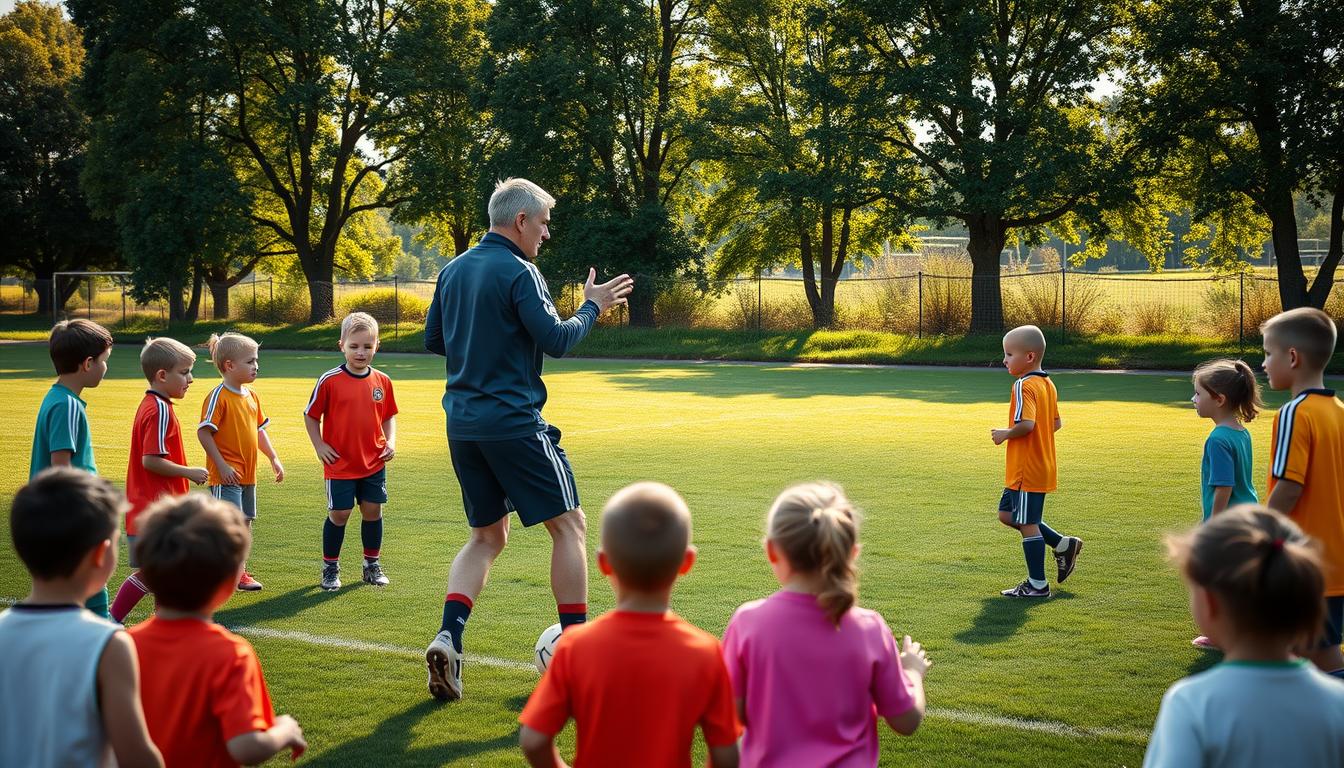How to Coach Your Child in Soccer: Tips and Techniques

Helping young athletes grow in soccer requires more than just teaching rules. It’s about creating a space where they feel excited to learn and explore. Studies show that clear, engaging coaching methods boost confidence in players while making the sport enjoyable for everyone involved.
Whether you’re new to guiding young players or refining your approach, focusing on simplicity works best. Break skills into bite-sized steps, celebrate small wins, and prioritize safety. This builds trust and keeps sessions fun.
Your role isn’t just about drills—it’s about nurturing a lifelong love for the game. This guide shares practical strategies tailored for kids, from mastering basics to designing practices that hold their attention. You’ll learn how to adapt techniques to different ages and skill levels while keeping energy high.
Key Takeaways
- Focus on creating a positive, low-pressure environment to encourage growth.
- Use age-appropriate drills that blend skill-building with play.
- Celebrate progress to boost confidence in young athletes.
- Balance teaching fundamentals with fostering creativity on the field.
- Prioritize safety and hydration during practices and games.
Understanding Youth Soccer Basics
Mastering youth soccer basics gives players confidence and helps teams succeed. Clear rules and simple drills create a foundation where kids can thrive. Parents and coaches play vital roles in explaining these concepts in ways young minds grasp quickly.
Key Rules for Young Players
Start with the no-hands rule: only goalkeepers can touch the ball with their arms. When the ball crosses sidelines, players use throw-ins—both feet on the ground, hands behind the head. Understanding boundaries (sidelines and end-lines) keeps the game flowing smoothly.
| Rule | Purpose | Example |
|---|---|---|
| No hands (except goalies) | Encourages footwork | Kicking instead of grabbing |
| Throw-ins for out-of-bounds | Restarts play fairly | Both feet planted during throw |
| Corner kicks | Resumes play after end-line exit | Attacking team kicks from corner |
Fundamental Skills and Simple Drills
Dribbling and passing form the core of soccer skills. Use cones for zigzag dribbling drills to improve control. Pair players for short passes, focusing on accuracy over power. For shooting, set up targets in practice nets to build aim.
Consistent communication between coaches and parents ensures everyone reinforces the same techniques. Try these effective tips for skill-building during practice time. Keep drills short—5 to 10 minutes—to match young attention spans.
Creating a Fun and Active Training Environment
Transforming practice into play keeps young athletes eager to learn. A lively session balances skill-building with laughter, letting kids enjoy the sport while developing coordination and teamwork. The key? Keep the ball moving and energy high.
Maximizing Ball Rolling Time
Limit downtime with quick transitions between activities. Use small-sided games (3v3 or 4v4) to ensure more touches per player. Set up multiple stations so everyone stays engaged—no waiting in lines. For example:
| Drill Type | Focus | Duration |
|---|---|---|
| Dribble Races | Ball control | 5 minutes |
| Passing Gates | Accuracy | 7 minutes |
| Shooting Targets | Precision | 6 minutes |
Game-Like Drills for Engagement
Turn drills into mini-games kids recognize. “Shark Attack” teaches dribbling under pressure—players avoid tagged teammates in a marked area. “Capture the Cone” blends passing and strategy as teams knock down opponents’ cones.
Rotate activities every 10-12 minutes to match attention spans. Celebrate creative moves, like unexpected passes or clever footwork. This approach builds skills while making youth soccer feel like recess with a purpose.
How to coach your child in soccer
Great youth soccer experiences start with recognizing every player’s potential. A player-centered approach prioritizes individual growth over rigid drills, creating adaptable learners who enjoy the process. Experts like Kris Van Der Haegen emphasize this method builds confidence through personalized feedback and creative freedom.

Using a Player-Centered Approach
This method means observing what each child needs. Rob Sherman, a youth development specialist, notes parents and coaches should ask questions like: “What excites them?” or “Where do they hesitate?” Adjust activities to match energy levels and interests. For example, shy players thrive in small-group games, while competitive kids love timed challenges.
| Traditional Approach | Player-Centered Approach |
|---|---|
| Focuses on team outcomes | Prioritizes individual progress |
| Fixed practice plans | Adapts to daily moods/skills |
| Coaches lead every drill | Players help design activities |
Simple Session Structures That Work
Start with dynamic warm-ups like “Follow the Leader” dribbling. Then, split into skill stations—one for passing accuracy, another for creative moves. End with a mini-scrimmage where kids apply learned techniques. Rotate roles weekly so everyone experiences defense, midfield, and attack.
Align sessions with the season’s goals. Early weeks might focus on ball control, while later practices introduce positional play. Parents can reinforce skills at home by playing 1v1 keep-away or setting up obstacle courses. Celebrate small wins—like a perfect pass or clever pivot—to keep motivation high.
Planning and Organizing Effective Practice Sessions
Successful soccer sessions start with smart preparation. A well-structured plan keeps soccer players focused while making the most of every minute. Research shows organized practices improve skill retention by 40% compared to unstructured playtime.
Setting Clear Objectives with Simple Equipment
Begin each session with one primary goal—like improving passing accuracy or defensive positioning. Use basic tools that match your objective:
| Focus Area | Equipment Needed | Time Allocation |
|---|---|---|
| Dribbling | Cones, small goals | 15 minutes |
| Passing | Flat discs, pinnies | 20 minutes |
| Shooting | Portable nets, balls | 25 minutes |
This approach helps soccer coaches create focused drills without overwhelming players. For passing practice, try these target-based exercises that build muscle memory through repetition.
Mapping Out the Field and Drills
Use colored cones to mark specific zones that mimic real-game scenarios. A 30×20 yard grid works well for small-sided games. Here’s a proven session structure:
| Phase | Activity | Purpose |
|---|---|---|
| Warm-Up | Dynamic stretches + ball rolls | Prepares muscles |
| Skill Focus | 3-station rotation | Builds technique |
| Game Time | 4v4 scrimmage | Applies skills |
Rotate activities every 12 minutes to maintain energy. This process keeps young athletes engaged while reinforcing key concepts. Remember—the best sessions feel like playtime with purpose.
Effective Communication and Positive Feedback
Clear communication turns soccer drills into growth moments. When working with kids, short phrases and upbeat tones keep their attention locked on the ball and the game. Studies show young athletes respond best to instructions under seven words—like “pass quickly” or “eyes up.”
Using Clear, Simple Language
Replace complex terms with action words. Instead of “utilize peripheral vision,” say “look around.” During training, demonstrate moves while speaking—kids mirror actions faster when they see and hear cues. Use hand signals for common directions, like pointing where to pass.
| Effective Phrase | Ineffective Phrase | Why It Works |
|---|---|---|
| “Shield the ball” | “Maintain possession under pressure” | Direct & visual |
| “Switch sides” | “Redistribute play to the weak side” | Easy to grasp |
| “Mark #10” | “Provide man-to-man defensive coverage” | Specific & actionable |
Encouraging Growth with Feedback
Highlight what players do right first. For example: “Great footwork! Now try passing earlier.” This way, corrections feel like upgrades, not criticism. Give feedback during water breaks or while resetting drills to avoid stopping play.
Ask questions like “Which pass felt best?” to understand their learning process. Adjust your advice based on their answers—some kids need technical fixes, others need confidence boosts. Celebrate effort over results with high-fives or team cheers.
Quick tips for game days: Use code words (“Banana!” = spread wide) and keep sideline instructions to three-second bursts. This keeps the focus on fun while building skills naturally.
Incorporating Play to Enhance Skill Development
Play sparks creativity while building essential soccer abilities naturally. When kids enjoy activities, they absorb techniques faster and develop problem-solving instincts. Research shows players in playful environments improve decision-making by 30% compared to traditional drills.
Adapting Drills for Different Age Groups
Tailor activities to match developmental stages. Younger players thrive with imaginative games, while older athletes benefit from tactical challenges. Adjust rules and equipment to keep every group engaged at their skill level.
| Age Group | Drill Focus | Example Activity |
|---|---|---|
| 5-7 years | Basic coordination | Animal dribbling (hop like rabbits) |
| 8-10 years | Team passing | Triangle keep-away |
| 11+ years | Positional awareness | 4-goal directional game |
Small-Sided Games and Interactive Challenges
Reduce field sizes to increase touches and quick thinking. Try 3v3 matches with rotating goals or “capture the flag” using soccer balls. These setups force players to communicate and adapt.
Create problem-solving scenarios:
- Defend a lead with fewer players
- Score using only left-foot passes
- Recover possession in 30 seconds
This guide helps build a love for soccer through laughter and experimentation. Families can recreate these drills at home using backyard space. The result? Confident players who see the field as their playground.
Wrapping Up Your Youth Soccer Coaching Journey
Guiding young players in soccer starts with the basics. Focus on creating a positive environment where skill-building feels like play. Keep sessions safe, structured, and packed with encouragement—this approach helps kids thrive.
Clear communication remains your key tool. Break down techniques into simple steps, and celebrate progress along the way. Organized practices with varied drills keep energy high and learning consistent.
Every day offers a chance to reinforce these principles. Whether refining passing accuracy or fostering teamwork, stay patient and adaptable. Small improvements add up over time.
Remember your role goes beyond teaching moves. You’re shaping confidence and joy in the sport. Stick to the basics, and let creativity flourish naturally.
With one focused session at a time, you’ll build players who love the game as much as they respect it. That’s the real win.
